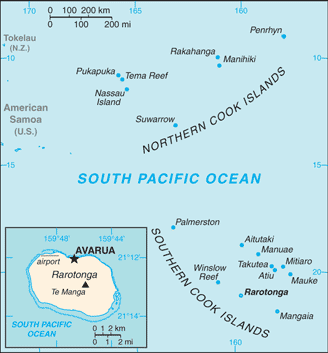Oceania > Cook Islands: Weather, Map, Costs and Travel Guide

Cook Islands : When and where to go?
Click on a city for complete climate and weather tables
| Town | Jan | Feb | Mar | Apr | May | June | July | Aug | Sept | Oct | Nov | Dec |
| Avarua |  |  |  |  |  |  |  |  |  |  |  |  |
Cook Islands: Climate & Weather
The islands undergo a tropical climate which is tempered by the trade winds. The warmest temperatures are between November and March (between 21 and 30 ° C), with tropical rains bringing great humidity. |
Weather today Mostly Cloudy max. 27 °C
min. 25 °C Wind: 10 km/h Precipitation forecast: 0 mm > Full report and 7-days forecast Data updated at 12:11 (local time) At that time, the weather was:  27 °C / Mostly Cloudy
27 °C / Mostly Cloudy
|
Cook Islands: Map |
Sponsored links |
What to do in Cook Islands
Rarotonga, the largest island, is also the highest, and it gathers half of the inhabitants of the country. Covered with lush vegetation, it offers a typical jungle landscape in the Takuvaine Valley. In the capital Avarua you can visit the Punanga Nui Market, where you can taste the local gastronomy, the National Museum, and the Christian Church. It is also there that is located the highest peak of the archipelago, Mount Te Manga, at 653 meters of altitude.
On Mangaia you will discover the cave of Teruare, with its stalactites and stalagmites, and the coasts of the island covered with yellow hibiscus, as well as its marshes, lakes and magnificent beaches. Aitutaki, a heavenly atoll, boasts one of the most beautiful lagoons in the Cook Islands: three luxury hotels are now open, and there is an airport linking it to Roratonga. It is the most touristic atoll, and you will enjoy the charming little town of Arutanga, which has remained very picturesque. On Manihiki, an atoll made up of 40 islets surrounding a wide lagoon, you can discover the black pearls of the oysters hidden at the bottom of the water, as on Penrhyn, itself surrounded by a ring of coral. On Atiu you will find beaches hardly accessible but deserted, which will make you believe on the first morning of the world! This island also has a richer fauna than other islands, especially with regard to birds. If you have the opportunity, do not miss attending the traditional dances of each island, and listen to their music, based on songs and percussion. In April of each year, we elect the best dancer of Cook: festivities not to be missed! The same goes for Gospel Day, or Nuku, on October 27th, where the Cooks sing open-air gospels. |
Cook Islands: The basics
For European nationals, no visa requirement, a passport is sufficient if it is valid 6 months after the date of return, unless you plan to stay longer than one month.
The current currency is the New Zealand Dollar (NZD). You can take a Paris / Roratonga flight via London and Los Angeles. The airport is 3 km from the city center. To move around the archipelago, the most convenient is the scooter, and you can also on some islands rent a car. Cycling is another option, as the distances are reduced. On Roratonga, buses run during the week. There are also taxis on Aitu and Roratonga (to be booked in advance) and there are air links between the islands. Budget: the budget to be envisaged is about 70 € per person per day. Health: It is best to have up to date her classic vaccinations, and recommended to be vaccinated against typhoid and hepatitis A and B for a long stay. Protect against mosquitoes and take care of injuries caused by corals. Security: the territory is safe, there is no special precaution to take. Shopping: In addition to the black pearls, you can bring souvenirs such as colorful patchwork quilts (tivaevaes), woven hats, wooden and pearl jewelery and wooden sculptures depicting primitive deities. |











